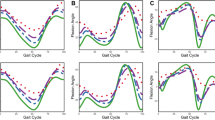Abstract
The goal of this study was to examine the optimal strategies for the recognition of gait phase based on surface electromyogram (sEMG) of leg muscles while children with cerebral palsy (CP) walked on a treadmill. Ten children with CP were recruited to participate in this study. sEMG from eight leg muscles and leg position signals were recorded while subjects walked on a treadmill. The position signals of left and right legs were used to develop a five gait sub-phases classifier, i.e., mid stance, terminal stance, pre-swing, mid swing, and terminal swing. Seven feature sets of sEMG signals were tested in recognizing the five gait sub-phases of children with CP. Results from this study indicated that the recognition performance of mean absolute value and zero crossing was better than that with other feature sets when using support vector machine (average classification accuracy was 89.40%). Further, we found that the performance of gait phase recognition is relatively better in pre-swing than other sub-phases, and the performance of gait phase recognition is relatively poorer in mid-swing than other sub-phases. Results from this study may be used to develop an intention-driven robotic gait training system/paradigm for assisting walking in children with CP through robotic training.






Similar content being viewed by others
References
Asghari Oskoei, M., and H. Hu. Myoelectric control systems—a survey. Biomed. Signal Process. Control 2:275–294, 2007.
Borggraefe, I., J. S. Schaefer, M. Klaiber, E. Dabrowski, C. Ammann-Reiffer, B. Knecht, S. Berweck, F. Heinen, and A. Meyer-Heim. Robotic-assisted treadmill therapy improves walking and standing performance in children and adolescents with cerebral palsy. Eur. J. Paediatr. Neurol. 14:496–502, 2010.
Druzbicki, M., W. Rusek, S. Snela, J. Dudek, M. Szczepanik, E. Zak, J. Durmala, A. Czernuszenko, M. Bonikowski, and G. Sobota. Functional effects of robotic-assisted locomotor treadmill thearapy in children with cerebral palsy. J. Rehabil. Med. 45:358–363, 2013.
Englehart, K., B. Hudgins, and P. A. Parker. A wavelet-based continuous classification scheme for multifunction myoelectric control. IEEE Trans. Bio-med. Eng. 48:302–311, 2001.
Gordon, K. E., and D. P. Ferris. Learning to walk with a robotic ankle exoskeleton. J. Biomech. 40:2636–2644, 2007.
Li, Y., F. Gao, H. Chen, and M. Xu. Gait recognition based on EMG with different individuals and sample sizes. In: Control Conference (CCC), 2016 35th Chinese IEEE, pp. 4068–4072, 2016.
Neumann, D. A. Kinesiology of the musculoskeletal system: foundations for rehabilitation. Amsterdam: Elsevier Health Sciences, 2013.
Palisano, R., P. Rosenbaum, S. Walter, D. Russell, E. Wood, and B. Galuppi. Development and reliability of a system to classify gross motor function in children with cerebral palsy. Dev. Med. Child Neurol. 39:214–223, 1997.
Phinyomark, A., P. Phukpattaranont, and C. Limsakul. Feature reduction and selection for EMG signal classification. Expert. Syst. Appl. 39:7420–7431, 2012.
Phinyomark, A., F. Quaine, S. Charbonnier, C. Serviere, F. Tarpin-Bernard, and Y. Laurillau. EMG feature evaluation for improving myoelectric pattern recognition robustness. Expert. Syst. Appl. 40:4832–4840, 2013.
Ryu, J.-H. and D.-H. Kim. Multiple gait phase recognition using boosted classifiers based on sEMG signal and classification matrix. In: Proceedings of the 8th International Conference on Ubiquitous Information Management and Communication. Siem Reap, Cambodia: ACM, pp. 1–4, 2014.
Tkach, D., H. Huang, and T. A. Kuiken. Study of stability of time-domain features for electromyographic pattern recognition. J. Neuroeng. Rehabil. 7:21, 2010.
Van Eck, M., A. J. Dallmeijer, I. S. van Lith, J. M. Voorman, and J. G. Becher. Manual ability and its relationship with daily activities in adolescents with cerebral palsy. J. Rehabil. Med. 42:493–498, 2010.
Vos, R. C., J. G. Becher, M. Ketelaar, D.-W. Smits, J. M. Voorman, S. S. Tan, H. A. Reinders-Messelink, and A. J. Dallmeijer. Developmental trajectories of daily activities in children and adolescents with cerebral palsy. Pediatrics 132:e915–e923, 2013.
Willerslev-Olsen, M., T. H. Petersen, S. F. Farmer, and J. B. Nielsen. Gait training facilitates central drive to ankle dorsiflexors in children with cerebral palsy. Brain 138:589–603, 2015.
Wu, M., J. Kim, D. J. Gaebler-Spira, B. D. Schmit, and P. Arora. Robotic resistance treadmill training improves locomotor function in children with cerebral palsy: a randomized controlled pilot study. Arch. Phys. Med. Rehabil. 98:2126–2133, 2017.
Xin, L., Z. Rui, Y. Licai, and L. Guanglin. Performance of various EMG features in identifying ARM movements for control of multifunctional prostheses. In: YC-ICT’09. IEEE Youth Conference on Information, Computing and Telecommunication, pp. 287–290, 2009.
Yen, S. C., B. D. Schmit, J. M. Landry, H. Roth, and M. Wu. Locomotor adaptation to resistance during treadmill training transfers to overground walking in human SCI. Exp. Brain Res. 216:473–482, 2012.
Zecca, M., S. Micera, M. C. Carrozza, and P. Dario. Control of multifunctional prosthetic hands by processing the electromyographic signal. Crit. Rev. Biomed. Eng. 30:459–485, 2002.
Zeni, Jr, J. A., J. G. Richards, and J. S. Higginson. Two simple methods for determining gait events during treadmill and overground walking using kinematic data. Gait & Posture 27:710–714, 2008.
Acknowledgments
This study was funded by NIDRR/RERC: H133E100007 and Postgraduate Scientific Research and Innovation Projects in Hainan Province [Grant Number Hys2017-128].
Author information
Authors and Affiliations
Corresponding author
Additional information
Associate Editor Xiaoxiang Zheng oversaw the review of this article.
Rights and permissions
About this article
Cite this article
Wei, Pn., Xie, R., Tang, R. et al. sEMG Based Gait Phase Recognition for Children with Spastic Cerebral Palsy. Ann Biomed Eng 47, 223–230 (2019). https://doi.org/10.1007/s10439-018-02126-8
Received:
Accepted:
Published:
Issue Date:
DOI: https://doi.org/10.1007/s10439-018-02126-8




